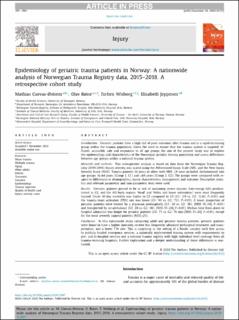| dc.contributor.author | Cuevas-Østrem, Mathias | |
| dc.contributor.author | Røise, Olav | |
| dc.contributor.author | Wisborg, Torben | |
| dc.contributor.author | Jeppesen, Elisabeth | |
| dc.date.accessioned | 2023-01-06T12:32:29Z | |
| dc.date.available | 2023-01-06T12:32:29Z | |
| dc.date.created | 2020-11-06T08:14:44Z | |
| dc.date.issued | 2020 | |
| dc.identifier.citation | Cuevas-Østrem, M., Røise, O., Wisborg, T., & Jeppesen, E. (2021). Epidemiology of geriatric trauma patients in Norway: A nationwide analysis of Norwegian Trauma Registry data, 2015–2018. A retrospective cohort study. Injury, 52(3), 450-459. | en_US |
| dc.identifier.issn | 0020-1383 | |
| dc.identifier.uri | https://hdl.handle.net/11250/3041587 | |
| dc.description.abstract | Geriatric patients have a high risk of poor outcomes after trauma and is a rapid-increasing group within the trauma population. Given the need to ensure that the trauma system is targeted, efficient, accessible, safe and responsive to all age groups the aim of the present study was to explore the epidemiology and characteristics of the Norwegian geriatric trauma population and assess differences between age groups within a national trauma system.
This retrospective analysis is based on data from the Norwegian Trauma Registry (2015-2018). Injury severity was scaled using the Abbreviated Injury Scale (AIS), and the New Injury Severity Score (NISS). Trauma patients 16 years or older with NISS ≥9 were included, dichotomized into age groups 16–64 years (Group 1, G1) and ≥65 years (Group 2, G2). The groups were compared with respect to differences in demographics, injury characteristics, management and outcome. Descriptive statistics and relevant parametric and non-parametric tests were used.
Geriatric patients proved to be at risk of sustaining severe injuries. Low-energy falls predominated in G2, and the AIS body regions ‘Head’ and ‘Pelvis and lower extremities’ were most frequently injured. Crude 30-day mortality was higher in G2 compared to G1 (G1: 2.9 vs. G2: 13.6%, P<0.01) and the trauma team activation (TTA) rate was lower (G1: 90 vs. G2: 73%, P<0.01). A lower proportion of geriatric patients were treated by a physician prehospitally (G1: 30 vs. G2: 18%, [NISS 15–24], P<0.01) and transported by air-ambulance (G1: 24 vs. G2: 14%, [NISS 15–24], P<0.01). Median time from alarm to hospital admission was longer for geriatric patients (G1: 71 vs. G2: 78 min [NISS 15–24], P<0.01), except for the most severely injured patients (NISS≥25).
In this nationwide study comparing adult and geriatric trauma patients, geriatric patients were found to have a higher mortality, receive less frequently advanced prehospital treatment and transportation, and a lower TTA rate. This is surprising in the setting of a Nordic country with free access to publicly funded emergency services, a nationally implemented trauma system with requirements to pre- and in-hospital services and a national trauma registry with high individual level coverage from all trauma-receiving hospitals. Further exploration and a deeper understanding of these differences is warranted. | en_US |
| dc.language.iso | eng | en_US |
| dc.publisher | Elsevier | en_US |
| dc.rights | Navngivelse 4.0 Internasjonal | * |
| dc.rights.uri | http://creativecommons.org/licenses/by/4.0/deed.no | * |
| dc.title | Epidemiology of geriatric trauma patients in Norway: A nationwide analysis of Norwegian Trauma Registry data, 2015-2018. A retrospective cohort study. | en_US |
| dc.type | Peer reviewed | en_US |
| dc.type | Journal article | en_US |
| dc.description.version | publishedVersion | en_US |
| dc.rights.holder | the authors | en_US |
| dc.subject.nsi | VDP::Medisinske Fag: 700 | en_US |
| dc.source.pagenumber | 450-459 | en_US |
| dc.source.volume | 52 | en_US |
| dc.source.journal | Injury | en_US |
| dc.source.issue | 3 | en_US |
| dc.identifier.doi | 10.1016/j.injury.2020.11.007 | |
| dc.identifier.cristin | 1845473 | |
| dc.relation.project | SHARE - Centre for Resilience in Healthcare: 5091 | en_US |
| cristin.ispublished | true | |
| cristin.fulltext | original | |
| cristin.fulltext | original | |
| cristin.qualitycode | 1 | |

